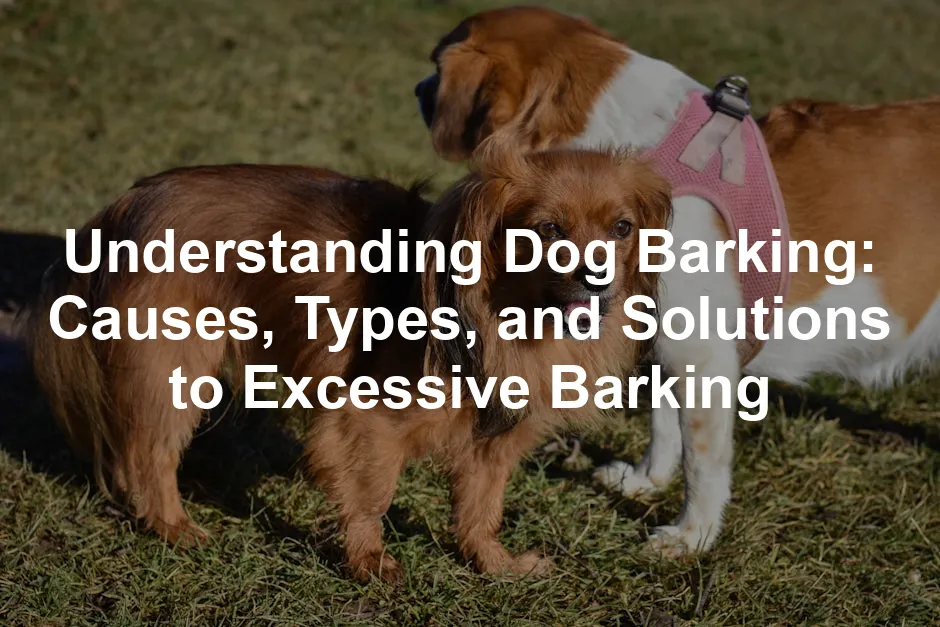Introduction
In a world filled with communication, our furry friends have their very own way of expressing themselves—through barking! While a dog’s bark can be an endearing aspect of their personality, it can also transform into a source of frustration for owners and neighbors alike. Imagine trying to enjoy your favorite Netflix series, only to be interrupted by a chorus of howls and woofs! In this comprehensive guide, we’ll unravel the complexities of dog barking, delve into the reasons behind it, and provide actionable solutions to help manage excessive barking.
Barking is more than just noise; it serves various functions in canine communication. Dogs bark to express excitement, alert their humans to potential dangers, or even to express their boredom. Yes, boredom! If your pup has decided that barking is the best way to get your attention, it might be time to re-evaluate their daily routine. So, whether you’re a proud dog owner, a prospective adopter, or simply a curious animal lover, buckle up as we embark on this woof-tastic exploration of canine communication!
Understanding why dogs bark is the first step toward addressing any excessive barking issues. Different types of barks convey various messages, and recognizing these distinctions can save you a lot of headaches. For instance, a playful bark differs from a territorial bark, and knowing the difference can help you respond appropriately.
If your dog barks at a passing squirrel, it may just be their way of saying, “Hey, look at that little intruder!” On the flip side, if they bark every time someone walks by your house or during a thunderstorm, it could signal fear or anxiety. By the end of this guide, you’ll be equipped with the knowledge to decode your dog’s vocalizations, ultimately leading to a more harmonious household.
With plenty of tips, training techniques, and environmental modifications to explore, you’ll find the right approach to manage your dog’s barking behavior. So let’s jump in and discover what makes your pup bark and how you can turn the volume down on excessive barking. Happy reading!

Why Do Dogs Bark?
Dogs bark for a variety of reasons. Understanding these reasons helps us respond appropriately.
First up, we have attention-seeking barking. Your furry friend might bark simply to grab your attention. Maybe they want to play, go outside, or just need a good scratch behind the ears. If you respond to this barking, your pooch learns that barking gets results.
Next is excitement barking. Picture this: You come home after a long day, and your dog greets you like a superstar! This kind of barking is all about joy and enthusiasm. It’s their way of saying, “I’m so happy you’re here!”
Then there’s fear or anxiety barking. Dogs can be sensitive creatures. Loud noises, unfamiliar people, or even changes in the environment can trigger their concern. If your dog is barking out of fear, it’s crucial to provide comfort and reassurance.
Let’s not forget territorial behavior. Dogs are natural protectors. They bark to establish their territory and warn potential intruders. If your dog barks at the mailman or passing pedestrians, it’s their way of saying, “This is my turf!”
As you work on understanding your dog’s needs, consider using a Dog Training Whistle. It can be an effective tool to communicate with your dog, especially during training sessions, promoting better understanding between you two.
Understanding training techniques can enhance your dog’s behavior and reduce barking. training techniques for deaf or blind dogs
Understanding these reasons can greatly enhance your bond with your canine companion. When we recognize their barking language, we can better meet their needs and help them feel secure.

Types of Barking
Common Bark Types and Their Meanings
Alert Barking: This type of barking serves as a warning signal. Dogs may bark when they perceive a threat. It’s their way of saying, “Hey, something’s not right!” This bark is usually sharp and loud, meant to grab your attention.
Demand Barking: Ever heard your dog bark when they want a treat or a toy? That’s demand barking! It’s their not-so-subtle way of saying, “I want that now!” This bark is often persistent until they get what they desire.
Play Barking: When dogs are in the middle of a fun game, they often bark with excitement. This type of barking is usually high-pitched and cheerful, reflecting their joy during playtime. It’s like saying, “Let’s keep this fun going!”
Fear Barking: This bark can be a sign of anxiety or discomfort. Dogs may bark when they’re scared or startled. The sound can be more frantic and high-pitched, indicating they’re feeling threatened.
Boredom Barking: If your dog is barking out of boredom, it could mean they need more engagement. This type of barking can be monotonous and repetitive, signaling your pup needs some mental or physical stimulation.
Separation Anxiety Barking: Dogs can become distressed when left alone. This barking often occurs when they feel lonely or anxious. It can be quite loud and frantic, expressing their desire for companionship.
Identifying Your Dog’s Bark
Deciphering your dog’s bark can be a fun challenge! Pay attention to the context and their body language. Is their tail wagging, or are they tense? A playful bark usually comes with a happy demeanor, while a fearful bark might be paired with a rigid body.
Observing these cues can help you understand what your dog is trying to communicate. By taking the time to learn their bark vocabulary, you’ll strengthen your bond and improve your dog’s overall well-being.

The Downsides of Excessive Barking
Understanding the Impact
Excessive barking can strain neighbor relations. Picture a peaceful Sunday afternoon, and your dog’s howls echo through the block. Suddenly, your neighbor’s smile turns to a frown. Nobody wants to become “that neighbor,” right? Continuous barking can lead to complaints and even strained friendships.
Moreover, constant vocalizations can impact your dog’s mental and physical well-being. Just like humans, dogs experience stress. Excessive barking may indicate anxiety, boredom, or frustration. If your pup feels like a broken record, their stress levels could skyrocket. This stress can lead to health issues, including digestive problems and diminished immune function.
Ignoring excessive barking isn’t an option. When left unchecked, it can trigger behavioral problems. A dog that barks excessively may also develop habits like digging, chewing, or even aggression. Without intervention, your charming companion could evolve into a barking machine.
Identifying Excessive Barking
So, how do you know if your dog’s barking is excessive? Start by observing their barking patterns. If your dog barks for prolonged periods without a clear cause, it’s time to take action. A few barks at the mailman? Normal. Barking at invisible squirrels for hours? That’s a red flag.
Next, assess the context. Consider the triggers. Is your dog barking at passing cars, strangers, or simply out of boredom? By understanding the triggers, you can tackle the barking behavior more effectively.
If you notice your dog’s barking escalates with changes in routine, it’s another sign that something’s amiss. Maybe they bark more when you leave the house or when they’re bored. Understanding these patterns is key to addressing excessive barking.
By recognizing these signs, you can take the first step in managing your dog’s vocal behavior. After all, a happy dog leads to a happier home!
Solutions to Excessive Barking
Training Techniques
Effective training techniques can help address excessive barking. Start with ignoring barking for attention. When your dog barks for attention, resist the urge to respond. This teaches them that barking won’t earn them the desired response, leading to a quieter pup.
Next, teach your dog the “quiet” command. Begin by waiting for a moment when your dog barks. Then, calmly say “quiet” and hold a treat. When they stop barking, reward them with the treat. Repeat this process, gradually increasing the duration of silence before offering the reward. Consistency is crucial!
Redirecting attention is another powerful technique. Engage your dog in alternative activities when they start barking. Fetch, tug-of-war, or even Interactive Dog Toys can shift their focus and reduce the urge to bark. For tips on dog training, check out Dog training tips for adopting a rescue dog with anxiety.
Redirecting your dog’s attention can be an effective way to manage excessive barking. Dog training tips for adopting a rescue dog with anxiety
Lastly, reward calm behavior. Whenever your dog is quiet, provide positive reinforcement. This could be treats, praise, or affection. A little love goes a long way in encouraging your dog to remain calm!
By implementing these training techniques consistently, you can help your dog manage their barking behavior effectively. Remember, patience is key!

Environmental Modifications
Creating a calm environment is key to reducing your dog’s barking. Start by identifying and minimizing triggers that cause agitation. If your dog barks at strangers, consider blocking their view with curtains or fences. This simple change can work wonders!
Next, consider sound masking techniques. Soft music or white noise machines can cover up outside disturbances, making your home a sanctuary. Your dog will thank you for not having to guard against every passing car and squirrel!
Mental stimulation is another vital aspect. Dogs need activities to keep their minds engaged. Puzzle toys, treat-dispensing balls, and interactive games can keep their brains buzzing. A well-exercised dog is often a quieter one. Incorporate daily walks and play sessions to ensure your furry friend doesn’t develop a habit of barking out of boredom. For more insights on dog breeds that might help with allergies, check out Best hypoallergenic dog breeds for allergy sufferers.
Providing mental stimulation is crucial for a dog’s well-being and can help reduce barking. Best hypoallergenic dog breeds for allergy sufferers
Professional Help
Knowing when to seek professional help is crucial. If your dog’s barking becomes excessive despite your best efforts, it may be time to consult with a trainer or behaviorist. These experts can assess your dog’s behavior and provide tailored strategies to tackle the issue.
Group classes can be a game changer! They offer socialization opportunities and teach your dog to interact with others. This not only enhances their skills but also helps reduce anxiety-driven barking. Plus, it’s a great way for you to connect with fellow dog lovers. To make the most of your training sessions, consider investing in a high-quality Dog Training Clicker. It’s a simple yet effective tool to reinforce positive behaviors!
FAQs
Why does my dog bark at night?
Dogs can be quite the night owls! If your pup barks at night, it could be due to territorial behavior. They sense the world around them and feel the need to protect their turf. Loneliness is another culprit. Dogs are social creatures, and nighttime can feel isolating. If they’re left alone, they may express their feelings through barking. Lastly, noise disturbances can drive a dog to vocalize. A passing car, a neighbor’s cat, or even rustling leaves can trigger their barking instinct.
How can I stop my dog from barking at strangers?
Stopping your dog from barking at strangers requires a mix of socialization, distraction, and training commands. Start socializing your dog early. Expose them to different people and situations. This helps reduce the fear of strangers. When your dog starts barking, distract them with a toy or treat. Redirecting their focus can break the barking cycle. Training commands like “quiet” can also be effective. Reward them when they stop barking to reinforce the behavior. Consistency is key here; practice makes perfect!
Is it normal for dogs to bark when left alone?
Yes, it is normal! Many dogs bark when left alone due to separation anxiety. They can feel stressed or abandoned, leading to vocalizations. It’s their way of expressing discomfort. If your dog barks excessively when you leave, it may indicate they need more training or socialization. Desensitizing your dog to your absence can help. Start with short departures and gradually increase the time. This helps them learn that being alone is okay.
What should I do if my dog’s barking becomes a nuisance?
If your dog’s barking turns into a nuisance, it’s time to take action! Begin by identifying the cause of the barking. Is it boredom, fear, or attention-seeking behavior? Once you know the trigger, you can implement solutions. Create a structured routine with exercise and playtime to keep your dog engaged. If the barking persists, consult a professional trainer. They can help you tackle the issue with tailored strategies. Don’t hesitate to seek help if needed; a calmer pup means a happier home!
Can certain dog breeds bark more than others?
Absolutely! Some breeds are known for their vocal tendencies. Breeds like Beagles, Terriers, and Dachshunds tend to bark more than others. Their barking serves various purposes, from alerting to expressing excitement. It’s essential to understand that barking is part of their nature. By recognizing the barking tendencies of specific breeds, you can better manage their vocalizations. Training and socialization play crucial roles so that barking doesn’t become excessive. Embrace your dog’s unique personality while keeping the volume in check!
Please let us know what you think about our content by leaving a comment down below!
Thank you for reading till here 🙂 And remember, whether it’s a Soft Dog Bed for cozy nights or a Dog Bark Collar for training, your pup deserves the best!
All images from Pexels





